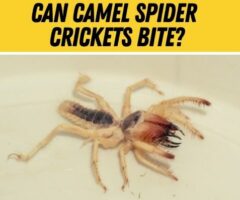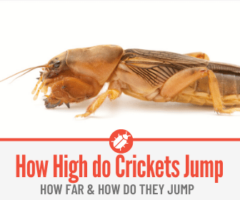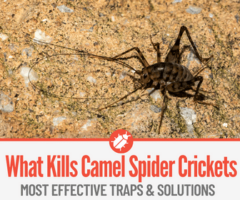 The world went crazy with curiosity about the camel spider after an out of proportion photo of two fighting camel spiders went viral.
The world went crazy with curiosity about the camel spider after an out of proportion photo of two fighting camel spiders went viral.
With all of that curiosity and speculation about the camel spider what’s really the truth about them?
Are they actually scary monsters & What do they eat?
What Do Camel Spiders Eat?
Most camel spiders eat things such as ants, bees, beetles, larvae, pupa, scorpions, silverfish, spiders, termites, wasps, and most other small bugs and insects.
A camel spider will eat whatever it can get its eight legs on, so they have also been known on occasion to eat things such as small birds, lizards, rodents, and snakes. The rodents that a camel spider eats are often things like the mouse, mole, and shrew. Larger prey such as rats are not really a realistic meal for most camel spiders as they are simply too large.
Camel spiders are roughly six inches at their largest. There are several different types of camel spiders and they live in different locations globally.
What Do Giant Camel Spiders Eat
Adult camel spider will eat most insects that are commonly found in their territory. They also eat full grown, but small, birds, lizards, and various rodents. This pray gives the camel spider all the water that they need as well as provide a tasty meal. Ultimately the size of the prey is greatly determined by the size of the spider.
Camel spiders are generally five or six inches in size. Their size influences their food choices, as the larger the spider the larger the food they will usually seek out, though some camel spiders are braver than others and may try to bite off more than they can actually chew.
Typically, weather they are babies, adolescents, or adults they most often stick with the insects, larvae, and pupa that are available to them as their first meal of choice.
What Do Baby Camel Spiders Eat
Much like their adult counterparts, baby camel spiders are carnivores. Even as babies, camel spiders are meat eaters. As babies, with their smaller size, camel spiders tend to go after smaller prey. The bigger they grow the bigger their prey, but the size of their pray ends with small birds, small rodents, small lizards, and small bugs.
One of the best things that any camel spider, especially a baby one, can sink their teeth into is ant larvae. The ant larvae are packed with a ridiculously large amount of fat and protein.

Do Camel Spiders Drink Water?
Camel spiders will most often not drink water on their own if given a choice. Even when they are in captivity and offered water within their containment, they will drink little to none of it. A camel spider gets almost all of the water in its diet from the pray that it eats.
How do camel spiders eat?
Although they lack venom, camel spiders use their sharp teeth and huge jaws to cut their prey into pieces. They then utilise digestive fluids to dissolve their victims into a consumable size.
Different Things People Believe Camel Spiders Could Eat
The camel spider didn’t really become a huge source of interest worldwide until 2006. This only occurred because a picture of two camel spiders fighting, which was taken completely out of scale and made the camel spiders appear to be more than a foot in size each was shared all over the internet and ultimately went viral. This caused a stir of mostly speculation and falsehoods rather than facts about the camel spider.
Foolishness such as camel spiders chasing down humans, taking them to the ground, and making a meal out of them or eating entire camel stomachs being the myths most commonly circulated.
In reality the camel spider is a fairly elusive and unknown creature. In captivity it is widely shared that the camel spider is known as a “diva”. They are high maintenance, require a lot of care, are incredibly picky, and are ultimately hard to maintain in captivity.
This makes them hard to study and difficult to gather true data and information on. In the wild, there is more studies and information on them, though not as much as some would hope. Because of the limited information its easy for such silliness and tall tales to be so widely shared about the camel spider.
Read More: Can Camel Spider Crickets Bite You
Can Camel Spiders Eat Lizards?
Depending on the geological location there are a range of types and sizes of the camel spider. This also determines in general how big their food will be. Camel spiders will eat lizards. The lizards they eat are usually very small.
Can Camel Spiders Eat Rats?
While some camel spiders will go after larger pray such as rats, it is far more common for the camel spider to eat mice, shrew, and moles. Rats can be very large, often fast moving, and will violently fight against a predator. These things all work together to make them a less than ideal meal for a camel spider.
Can Camel Spiders Eat Cats?
Camel spiders do not eat cats. For even the largest breed of camel spider, a cat is a fairly large animal to try and turn into a meal. They are simply not a good choice for a camel spider meal.
Can Camel Spiders Eat Scorpions?
Camel spiders do eat scorpions. In fact, the camel spider is an invertebrate and is more accurately not a spider. Scorpions are just one of the many insect or spider type creatures that a camel spider will commonly eat. Camel Spiders are especially known to eat Scorpions in Texas.
Do Camel Spiders Eat Birds?
While birds may seem like a good snack for a camel spider, they truly are not. Camel spiders will more commonly chose things such as larvae and bugs for their typical choice meal. Though if a bird comes along and presents a good opportunity for a meal, only a very small ground bird will actually make the cut and become the camel spider’s meal.
Why Do Camel Spiders Kill Ants?
Camel spiders do not really care about a puny ant when it comes to making a meal. However, ant larvae and pupae which are baby and adolescent ants, are a highly sought-after snack for the camel spider because they are one of the best meals they can get. Baby and adolescent ants are packed with fat and protein, it is actually such a huge dose of and protein all at once that its like an energy shot meal.
Roaches
These are a common victim of the camel spider as they both run into each other in search of warmth. Any cockroach that is unfortunate enough to find itself in the path of a camel spider will probably become its next meal.
Slugs
Camel spiders are likely to come across slugs since they both seek shade under fallen logs and rocks. It is therefore incredibly easy for camel spiders to catch and eat slugs along with any other small insects seeking shade and moisture.
Bed bugs
Although camel spiders seek warmth and bed bugs prefer cooler climates, both can be found within cracks and crevices in walls. The camel spider’s ability to climb means that bed bugs found in these areas could very well become their next victim.
Termites
Similarly to bed bugs, termites prefer moist environments. However, should they both cross paths in the dark and damp areas of a house, camel spider’s will undoubtedly attack and consume these pests.
Fleas
Fleas are a likely victim of the camel spider as they also seek out warmer climates that are away from direct sunlight. Due to their small size, they would make good targets for a hungry camel spider.
Spiders
Camel spiders have been known to munch on their spider friends as well as members of their own kind. The camel spider’s ability to run at speeds of up to 10 miles per hour makes it easy to catch the average giant house spider with an average speed of 1.9km/h.
Things camel Spiders Can Eat in your Home:
A camel spider will sink it’s jaws into anything it comes across, providing it’s not too much bigger than itself. As temperatures drop outside, they will often seek the warmth of a nearby home. Once inside, they can and will feed off of whatever they can find:
Clothes
Camel spiders have been known to damage and even completely destroy clothes since they have no trouble tearing through fabric with their sharp teeth. This is particularly an issue if you keep your clothes in an area of the house which is humid such as within boxes in the basement. In order to protect your clothes, you should closely inspect each item when bringing it back into the house from outside.
Paper
Like clothing, camel spiders have no problem using their jaws as a weapon to pierce through paper. Anything that is left out for a camel spider to find, particularly in areas of the house that are poorly lit and a bit damp, will likely be demolished.
Insulation and walls
It is an easy task for camel spiders to chew through insulation and walls, although they tend to look for gaps in structures which they can easily crawl through. They can also cause a great deal of damage to wallpaper.
Dust
There is nothing to suggest that camel spiders wouldn’t attempt to eat any dust that is lying around, particularly as it is often found in attics and basements that are rarely disturbed. As scavengers, even the smallest bit of dust could attract them.
Hair
There is no evidence to suggest that camel spiders have any interest in eating hair. Despite the myths that circulated in South Africa about them giving you an unwanted trim at night, researchers have not found anything to back up this theory. However, if given the opportunity, it is likely that they wouldn’t turn it down.
Curtains
In addition to eating the fabric of clothes, camel crickets have also been known to chew on curtains. Since they often find their way in through gaps around doors and windows, it is highly likely that you can find them destroying the fabric as it is one of the first things they’ll come across.
There is little that can be done to protect these individual items, however, you can prevent them from entering your house in the first place by taking extra care to repair any cracks or crevices in doors and windows and regularly checking warm and damp areas in your house (the attic and basement).
What do Camel Spiders like to eat the most
Camel spiders tend to favour small insects that are easy to catch: this includes ants, crickets and locusts. Larger camel spiders have also been recorded to eat a variety of termites, wasps, beetles, scorpions and spiders, as well as rodents and small lizards.
Baby camel spiders are particularly fond of ant larvae, as this is easy to capture and consume.
What should I feed my pet Camel Spider
Camel spiders eat A LOT. The diet of your pet camel spider should consist of a range of insects like crickets, locusts, mealworms and cockroaches.
How often do Camel Spiders eat
They should be fed every other day, and the portion size can be measured so it is the same size as its abdomen.
If I come across a camel spider, what should I do?
Camel spiders are not a threat to humans as they do not have the venom to do any harm. Getting rid of a camel spider infestation requires the additional removal of all other pests in the area, and therefore it is wise to leave them unharmed unless they are causing a serious issue.
Although they look terrifying, camel spiders can be useful. They feed off of other venomous insects that we don’t want to find in our home, such as spiders or centipedes. Don’t disturb them and they won’t disturb you!
Related Topics
Is it true that camel spiders eat camels?
This is absolutely not true. Unlike the name suggests, these aggressive spiders tend to stick to much smaller prey that they can easily overpower. Although they have large jaws, the average sized camel spider would not be able to pierce through the skin of a camel.
Why Do Camel Spiders Chase people
Camel spiders do not actually chase people. The idea that they do actually comes from the fact that camel spiders will seek out cool and dark places to spend the hot days. When someone sees a camel spider following or running after them, what they are actually doing is trying to seek out a cool place to chill in your shadow.
Also Read: Why Do Camel Crickets Jump At You
The camel spider is not actually after you. In fact, the action of camel spiders running after people in order to hide in the cool relief that they are hoping to find in your shadow is actually what has sparked rumors and myths about how camel spiders chase down humans in order to attack them and turn them into a meal.
Do Camel Spiders Eat People?
Absolutely not. Camel spiders do not eat humans at all. In fact, camel spiders do not typically ear anything larger than a very small bird, mouse, or insects. Larger animals are just not realistic. While the camel spider may seem large, they average around six inches. They may seem scary, but in reality, they are harmless to humans.
How will I know if I have a camel spider infestation?
You could leave sticky traps around your home to determine if they are present inside. It is also important to regularly vacuum areas that are dark and away from sunlight in which they could be hiding.
Camel spiders are a very hungry class of Arachnida and pretty much anything of a similar size to them could become their next victim. Their diet is heavily influenced by the geographical location in which they are found, which makes them such a unique and interesting species.






